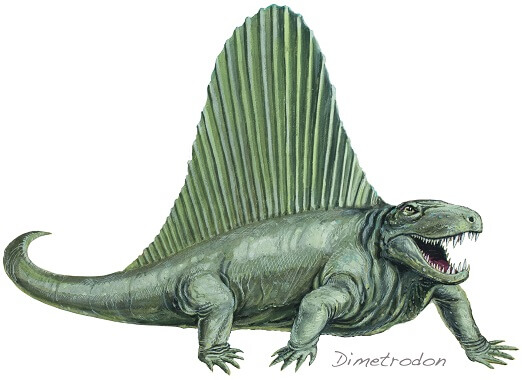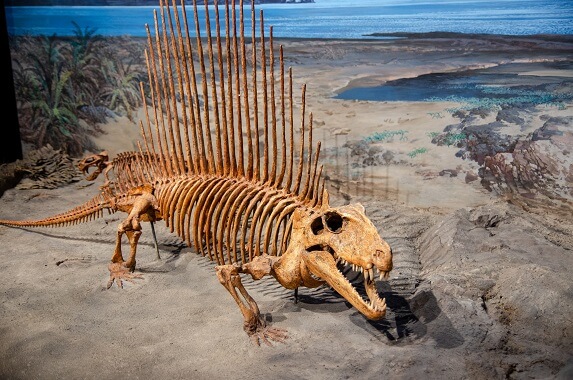
The Dimetrodon is a genus of predatory carnivores that lived during the Permian period, 280 – 260 million years ago. Although they are sometimes grouped with dinosaurs, these animals were more closely related to mammals than to true reptiles and evolved long before the dinosaurs did. It is believed they went extinct some 40 million years before the dinosaurs. While this creature looks like a dinosaur, the Dimetrodon is actually a reptile belonging to the order Pelycosauria. This group described mammal-like reptiles and the Dimetrodon had several mammal-like characteristics. The Dimetrodon is thought to have been well adapted to a wide range of habitats as its fossils have been found in Texas and Oklahoma in the US, Nova Scotia, Canada as well as all across Europe. The first fossil was discovered during the 19th century and was named by Edward Drinker Cope in 1878. It is difficult for scientists to deduce the kind of habitat that Dimetrodons would have preferred as the Earth would have looked a lot different when Dimetrodons were alive to how it looks today. As fossils have been found across North America and Europe, scientists expect that these animals were able to adapt to a variety of habitats ranging from dry, arid regions to wetter areas that were like swamps, with lots of vegetation and water. The Dimetrodon was cold-blooded like modern-day reptiles and walked on four legs. Its legs sprawled out to the side and it had a large tail that made up a large proportion of its body length. It is thought that it moved much like crocodiles do today. Fossils suggest that these animals were sexually dimorphic, with the males being larger than the females. While scientists can’t be sure what these creatures ate, they can be sure that Dimetrodon were meat-eaters. They had large, sharp teeth that were suitable for ripping and tearing at flesh. It is thought that the Dimetrodon would have laid eggs but it is near impossible for scientists to know the logistics of this animal’s reproduction. The Dimetrodon is an extinct mammal-like animal that lived millions of years before the dinosaurs evolved. Since the first discovery of its fossils in the late 19th century, scientists have been trying to piece together information about this animals existence. Scientists have discovered several biological adaptations that helped this creature survive millions of years ago and link the Dimetrodon to modern-day mammals. Let’s take a closer look! One distinctive characteristic of the Dimetrodon was the large sail on its back. The sail was presumably a membrane that was held up by elongated vertebral spines. Researchers think that this sail could have contained a lot of blood vessels and so was used in thermoregulation. The sail could have helped this large animal regulate its body temperature by absorbing heat from the sun during the day and using this heat to keep it warm at night. The large surface area of the sail could help this synapsid to warm up or cool off much more efficiently than other animals. One advantage that this adaption could have given Dimetrodon over other animals is that it would have been able to warm up much faster, and therefore would be active a lot sooner. This would have allowed the Dimetrodon to hunt prey that were more sluggish, making them easier to catch. Researchers think that the sail was also used in mating rituals and to warn off predators. The Dimetrodon wasn’t the only animal at this time that had a sail. A similar sail evolved independently in the Edaphosaurus, which were distant relatives of the Dimetrodon and both were Pelycosaurs. Dimetrodon means “two-measure teeth” and this animal got its name because it had two different types of teeth; shearing teeth and sharp canine teeth. They were the first terrestrial animal to have ziphodont teeth – sharp laterally compressed teeth with serrated edges. More interestingly, these teeth differed between the different species of Dimetrodon, as demonstrated by recent research. Scientists examined the teeth of three species of Dimetrodon that lived at different times. Dimetrodon milleri was the oldest and smallest species included in the study. Its sharp teeth were straight with cutting edges. Dimetrodon limbastus came later in the evolutionary tree and was much larger than Dimetrodon milleri. It had evolved small serrations in the enamel on some of its teeth which would be much more suited to cutting through skin and muscle than the teeth of its predecessor. The final species in the study Dimetrodon grandis had teeth that were even more specialized for cutting through flesh. Its teeth had prominent denticles that created a serrated age and was similar to the teeth of predatory dinosaurs. While these Dimetrodon species were not directly linked on the evolutionary tree, the difference in their size and teeth suggests that these animals evolved to hunt a variety of prey. Throughout this time, herbivores were becoming a lot larger and there were several other large carnivores to compete with. The Dimetrodon’s teeth likely evolved to help them target a wider range of prey and to allow them to hunt larger animals. While these animals looked more like reptiles than mammals, it had certain characteristics that relate it to the earliest mammals and make it a distant relative of humans. When scientists examined the skull of a Dimetrodon they found a single large hole there called the temporal fenestra, which is where some of the lower jaw muscles attach to the skull. What was significant about this finding is that animals that have a single hole in this area are called synapsids, which is the group of vertebrates to which modern mammals belong. In contrast, dinosaurs have two holes in this area and are called diapsids. This important finding showed that the Dimetrodon was not a dinosaur, but instead was a distant relative of modern mammals. In terms of evolution, the lineages containing the synapsids, such as the Dimetrodon and modern mammals, and those containing the reptiles, such as dinosaurs, split over 324 million years ago from a common lizard-like ancestor. Many early synapsids looked like reptiles so information like this is important to help us decipher how things evolved. What’s really interesting is that the Dimetrodon belongs to a group of synapsids called the sphenacodontians. This group also contains a distant relative of living mammals that would have looked very similar to Dimetrodon. This means that the Dimetrodon is some distant relative that lived long before the true mammals came about.
Kingdom
Animalia
Phylum
Chordata
Class
Synapsida
Order
Pelycosauria
Family
Sphenacodontidae
Genus
Dimetrodon
Species
15 known species
Length
More than 11.5 feet ( 3.5 meters)
Weight
550 lbs (226 kg)
Lifespan
Unknown
Social Structure
Unknown
Status
Extinct
Preferred Habitat
Unknown
Average Clutch size
Unknown
Diet
Carnivore
Main predators
Unknown
The Basics!

Fun Facts about the Dimetrodon!
Thermoregulation

Ziphodont Teeth

Are Humans Descended from the Dimetrodon?
